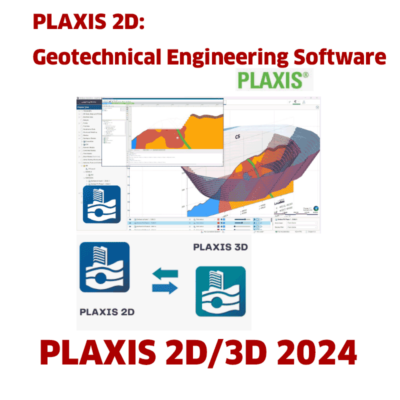|
PLAXIS 2D/3D 2024 geotechnical engineeringPLAXIS 2D/3D 2024 full crack download unlimited geotechnical engineeringPLAXIS 2D/3D 2024.2 v24.02.00.1144 x64 PLAXIS 2D/3D 2024 is a leading geotechnical engineering software suite used for the analysis of deformation, stability, and groundwater flow in soil and rock structures. Developed by Bentley Systems , PLAXIS is widely regarded as one of the most advanced tools for geotechnical engineers, researchers, and consultants working on projects such as foundations, tunnels, embankments, dams, excavations, and other earthworks. 
The 2024 version of PLAXIS continues to build on its reputation for accuracy, reliability, and user-friendly workflows, with enhanced capabilities for modeling complex geotechnical problems in both 2D and 3D environments.
PLAXIS 2D/3D 2024.2 v24.02.00.1144 x64 Key Features of PLAXIS 2D/3D 20241. Advanced Finite Element Analysis (FEA):- Provides robust finite element solvers for analyzing soil-structure interaction, deformation, and stability.
- Supports both linear and nonlinear material models for accurate representation of soil behavior.
2. Comprehensive Material Models:- Includes a wide range of constitutive models for soils, rocks, and structural materials:
- Elastic, Mohr-Coulomb, Hardening Soil, Soft Soil Creep, and more.
- Advanced models like Hypoplasticity and User-Defined Models for specialized applications.
- Allows calibration of material parameters based on laboratory or field data.
3. Coupled Flow and Deformation Analysis:- Simulates coupled pore pressure and deformation analysis for saturated and unsaturated soils.
- Enables modeling of consolidation, seepage, and groundwater flow in complex geotechnical systems.
4. Structural Elements:- Incorporates beams, plates, anchors, geogrids, and piles for modeling structural components interacting with the soil.
- Supports staged construction and excavation scenarios with ease.
5. Dynamic Analysis:- Performs seismic analysis and dynamic loading simulations, including earthquake-induced ground motion.
- Supports time-domain and frequency-domain analyses for vibration studies.
6. Thermal Analysis:- Models temperature effects on soil and structures, such as heat transfer in energy piles or thermal expansion in embankments.
- Useful for geothermal applications and environmental impact assessments.
7. 3D Modeling Capabilities:- PLAXIS 3D offers powerful tools for creating and analyzing complex 3D geometries.
- Includes mesh generation, refinement, and adaptive remeshing for high accuracy.
- Supports visualization of results in 3D, including displacement vectors, stress contours, and flow paths.
8. Staged Construction and Excavation:- Allows modeling of multi-stage construction processes, such as layer-by-layer embankment building or step-by-step tunnel excavation.
- Tracks changes in stress, strain, and pore pressure throughout the construction phases.
9. Probabilistic Analysis:- Incorporates uncertainty and variability in material properties using probabilistic methods.
- Enables risk assessment and reliability analysis for geotechnical designs.
10. Integration with Bentley Ecosystem:- Seamlessly integrates with other Bentley products like OpenGround for geotechnical data management.
- Supports interoperability with CAD and BIM tools for collaborative workflows.
11. Enhanced Visualization and Reporting:- Provides detailed graphical outputs, including contour plots, vector fields, and animations.
- Generates professional reports with customizable templates.
Applications of PLAXIS 2D/3D 2024- Foundation Design:
- Analyze shallow and deep foundations, including footings, rafts, and piles.
- Evaluate settlement, bearing capacity, and lateral loads.
- Tunneling and Underground Structures:
- Model tunnel excavation, lining installation, and ground support systems.
- Assess ground movement and stability during tunnel construction.
- Embankments and Dams:
- Simulate the construction and performance of embankments, levees, and dams.
- Analyze slope stability, seepage, and consolidation.
- Excavations and Retaining Walls:
- Design retaining walls, sheet piles, and diaphragm walls.
- Evaluate wall deflections, anchor forces, and groundwater effects.
- Seismic and Dynamic Studies:
- Perform earthquake simulations to assess liquefaction, ground amplification, and structural response.
- Study vibrations from machinery, traffic, or blasting operations.
|

